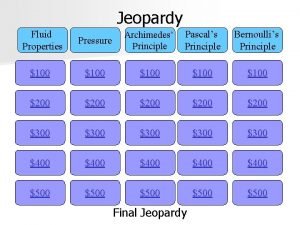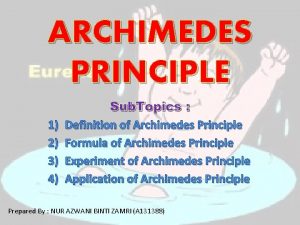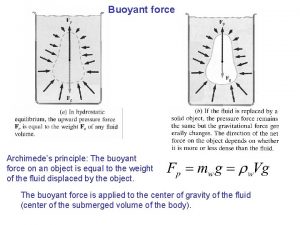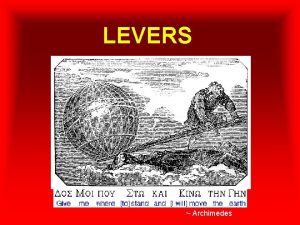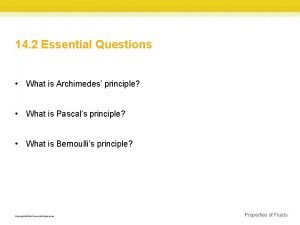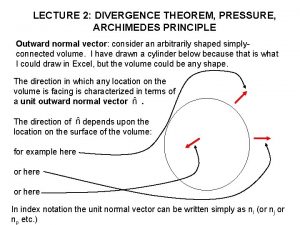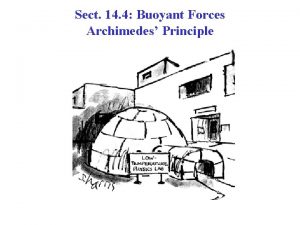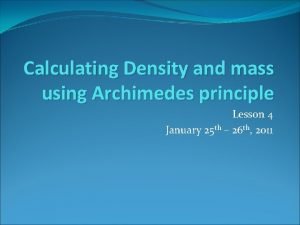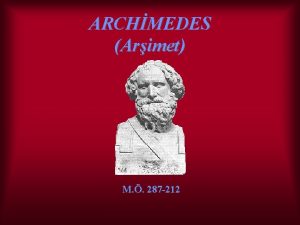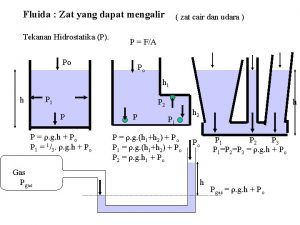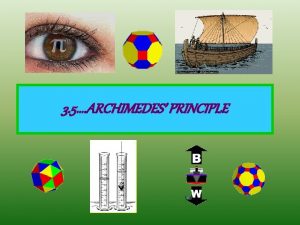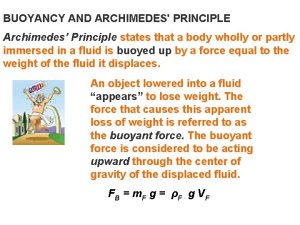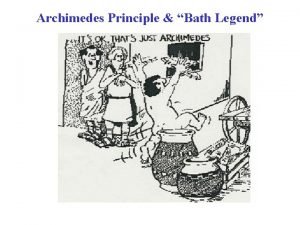3 5 ARCHIMEDES PRINCIPLE Who is Archimedes Archimedes






















- Slides: 22

3. 5…. ARCHIMEDES’ PRINCIPLE

Who is Archimedes? • Archimedes (287 -212 BC), pre-eminent Greek mathematician and inventor, who wrote important works on plane and solid geometry, arithmetic, and mechanics. – "Archimedes", Microsoft « Encarta « Encyclopedia 2001. ⌐ 1993 -2000 Microsoft Corporation. All rights reserved .

The law • Archimedes' Principle, law of physics that states that when an object is totally or partially immersed in a fluid, it experiences an upthrust equal to the weight of the fluid displaced. The principle is most frequently applied to the behaviour of objects in water, and helps to explain floating and sinking, and why objects seem lighter in water. It also applies to balloons in the air.

UPTHRUST AND BUOYANT FORCE The key word in the principle is “upthrust” (or buoyant force), which refers to the force acting upward to reduce the actual weight of the object when it is under water. for example, a metal block with a volume of 100 cm 3 is dipped in water, it displaces an equal volume of water, which has a weight of approximately 1 N. The block therefore seems to weigh about 1 N less.

SINKING AND FLOATING OBJECTS The reading of spring balance is 2. 7 N The reading of spring balance is 1. 7 N

What is the reading of spring balance if the wood is attached to it ? ZERO

Density and Buoyancy From Archimedes’s Principle : Buoyant Force = Weight of fluid displaced = mg (note : F = ma) = Vg (note : = m ) V Thus FB = Vg Where …… FB = Buoyant Force or Upthrust = Density of fluid V = Volume of fluid displaced or the volume of the object that immersed in the fluid.

Buoyant Force and Floatation Buoyant force = weight the object floats and stationary Buoyant force > weight the object moves up Buoyant force < weight the object moves down

The Law of Floatation A floating object displaces its own weight of fluid in which it floats.


THINK!!!!! warm fresh water cold fresh water warm sea water cold sea water 1. Why the depth of ship immersed in the water different?

Fresh water less dense than sea water and warm water less dense than coldwater so warm fresh water need to be displaced more to keep the uptrust force equal with weight of the boat so it still can float.

2. If the plasticine is formed into a ball, it will sink. But when it is formed into a hull it will float. Why? -

BECAUSE…. .

APPLICATIONS Hot air balloon 1. rises upwards (Upthrust > Weight of hot air (helium gas) + weight of airship fabric + weight of gondola + weight of passengers. )( balloon expand) 2. . descends (Upthrust < Weight of hot air (helium gas) + weight of airship fabric + weight of gondola + weight of passengers. )(balloon shrinks) 3. stationary (Upthrust = Weight of hot air (helium gas) + weight of airship fabric + weight of gondola + weight of passengers. )( balloon size uncanged)

PLIMSOLL LINE OF THE SHIP The density of sea water varies with location and season. To ensure that a ship is loaded within safe limits , the Plimsoll line marked on the body of the ship acts as a guide.

If ballast tanks empty Upthrust > weight submarine rises to surface If ballast tanks full Upthrust < weight submarine sinks to bottom SUBMARINE

Hydrometer An hydrometer is an instrument used to measure the density of a liquid. lead shot to make it float upright In a liquid of lesser density , the hydrometer is more submerged. The hydrometer floats higher in a liquid of higher density.

Example 1. The weight of the rock in air is 0. 85 N. When it is completely submerged in water, its weight is 0. 45 N. What is the buoyant force acting on the rock when it is completely submerged in the water ? Solution : Buoyant force = Actual weight – Apparent weight = 0. 85 – 0. 45 = 0. 4 N

2. A concrete slab weight 180 N. When it is fully submerged under the sea its apparent weight is 105 N. Calculate the density of the sea water if the volume of the sea water displaced by the concrete slab is 4800 cm 3. [ g = 9. 8 Nkg-1 ] Solution : Buoyant force = actual weight – apparent weight = 180 – 102 = 72 N

§ According to Archimedes’s principle Buoyant force = weight of sea water displaced Therefore, F = p. Vg so…. p = F / Vg = 72 / (4800 x 10 -6 x 9. 8 ) = 1530. 61 kg m-3

THE END PHYSICS IS SIMPLY FUN
 Teleso ponorene do kvapaliny je nadľahčované
Teleso ponorene do kvapaliny je nadľahčované Archimedes principle volume
Archimedes principle volume Pascal and archimedes principle
Pascal and archimedes principle Archimedes principle conclusion
Archimedes principle conclusion Buoyant force and archimedes principle
Buoyant force and archimedes principle Archimedes lever principle
Archimedes lever principle Chapter 22 heat transfer exercises answers
Chapter 22 heat transfer exercises answers Hydraulic machines move heavy loads in accordance with
Hydraulic machines move heavy loads in accordance with Hydrometer principle
Hydrometer principle Archimedes principle story
Archimedes principle story Divergence theorem
Divergence theorem Site:slidetodoc.com
Site:slidetodoc.com Buoancy meaning
Buoancy meaning Archimedes principle states that the buoyant force is
Archimedes principle states that the buoyant force is Calculate density using archimedes principle
Calculate density using archimedes principle Archimedes ( arşimet) (mö 287–212 )
Archimedes ( arşimet) (mö 287–212 ) Rumus gaya apung
Rumus gaya apung Archimedes lebenslauf
Archimedes lebenslauf Archimedes toruń
Archimedes toruń 212 bc
212 bc Archimedes erfindungen
Archimedes erfindungen Archimedés
Archimedés Grecki fizyk i matematyk z syrakuz
Grecki fizyk i matematyk z syrakuz


